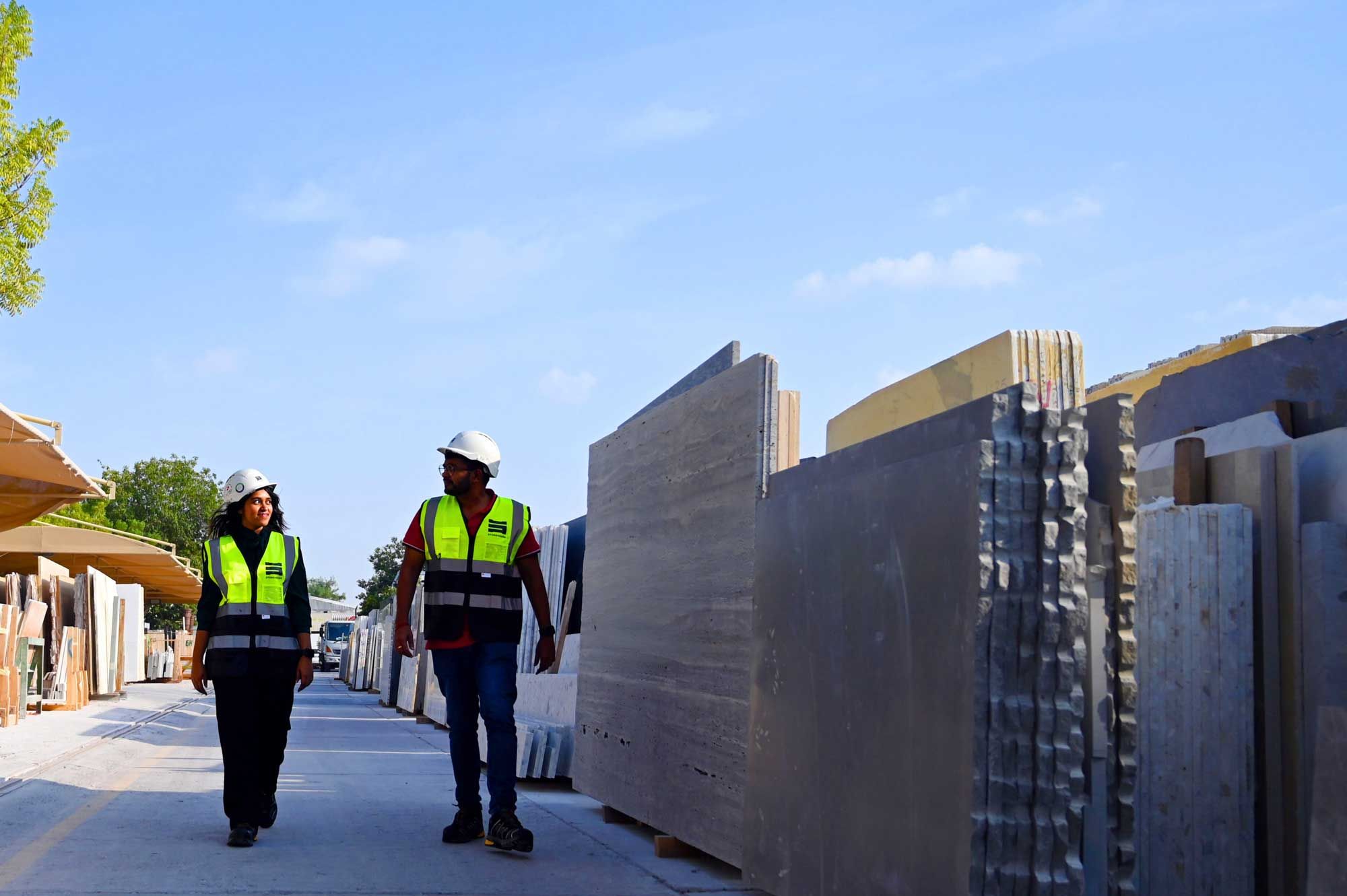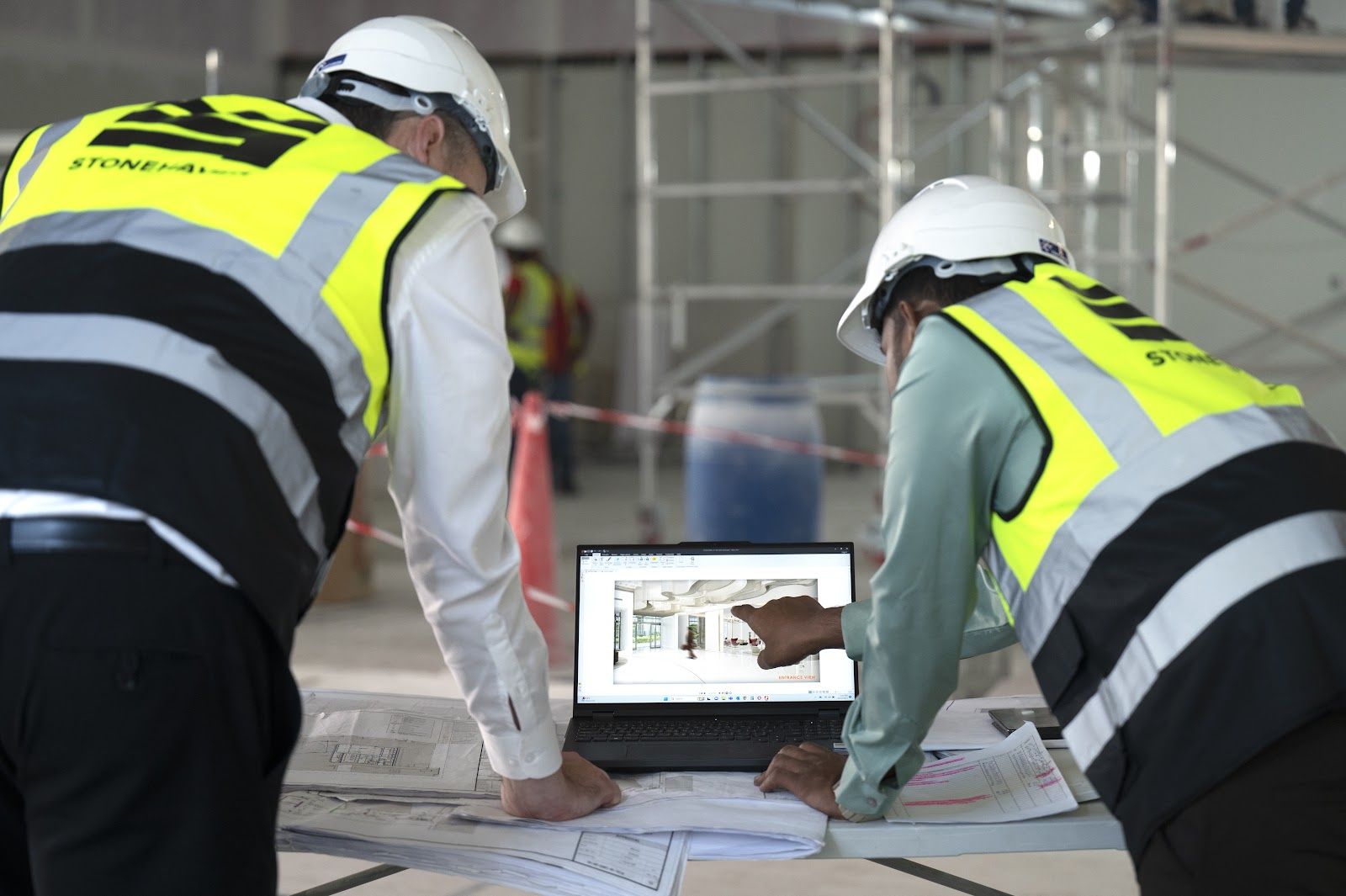In the fast-paced world of construction, seamless communication is the key to delivering projects successfully. The Request for Information (RFI) process is a fundamental tool that facilitates clear communication, resolves ambiguities, and ensures smooth project execution. However, managing RFIs effectively requires a deep understanding of their role, tools, and best practices.
This guide answers common questions about RFIs in construction and explores strategies for optimising their management using construction RFI strategies. Along the way, we’ll also touch on how project management consultancy services for construction can support these efforts, ultimately driving efficiency and success.
What is a RFI?
A RFI (Request for Information) in construction is a formalised process designed to address ambiguities, gaps, or inconsistencies in project documentation. It serves as a communication tool between contractors, subcontractors, architects, and clients, ensuring that all stakeholders share a unified understanding of the project. RFIs are essential in complex construction projects where the intricacies of design and execution can often lead to unanswered questions or conflicting information.
A comprehensive study by the Navigant Construction Forum analysed over 1,300 global construction projects, revealing that each Request for Information (RFI) costs approximately $1,080 to process, with an average response time of 9.7 days. These statistics point out the importance of efficient RFI management to maintain project schedules and control costs, especially in regions with significant construction investments.
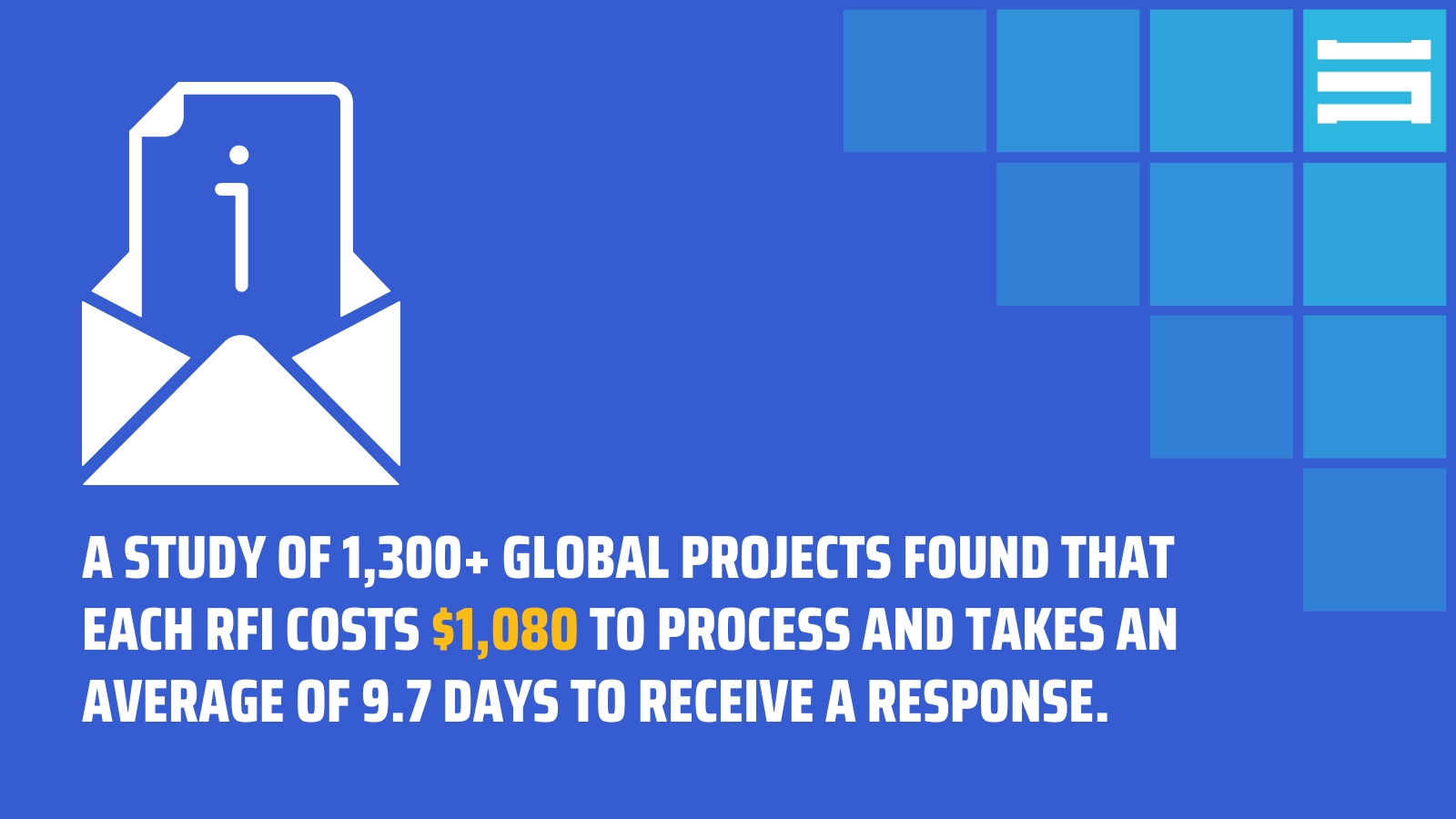
Approaches to Using RFIs
1. Structured Documentation:
Always use a standardised RFI format to maintain clarity. Including references such as drawing numbers, section names, or specification pages in the query ensures precise identification of the issue. Standardisation ensures that every RFI is complete, easy to read, and actionable. The main components of an RFI shouldn’t be limited to the following below:
- Unique RFI Number:
Assigning a unique identifier to each RFI helps in tracking and referencing the query throughout the project lifecycle. - Project Details:
Include project name, location, and relevant phase of work to provide context. - Description of the Query:
Clearly state the issue or question. For instance, "What material is specified for the fireproof coating on beams in Section A?" - Reference to Supporting Documents:
Include references to drawings, section numbers, or specification pages to pinpoint the exact issue. - Proposed Resolution (Optional):
Where possible, suggest a resolution to speed up the decision-making process. - Attachments:
Include images, sketches, or additional documentation to support the query.
2. Defined Response Timeframes:
Create contractual obligations that define response timeframes for RFIs, e.g., 7-10 days. This prevents delays in project workflows. If responses to RFIs are delayed, contractors or subcontractors may face bottlenecks in their work, causing project schedules to slip. Defined timeframes ensure that RFIs are prioritised and addressed promptly, keeping the project on track.
3. Use of Construction RFI Software:
Digital tools enable teams to submit, track, and manage RFIs seamlessly. For example, a contractor needing clarification on wall assembly might submit an RFI with detailed images and drawing references through the software, ensuring the architect can respond efficiently.
Imagine a contractor on-site discovers discrepancies in the flooring plan outlined in the project documents versus what is practical on-site. They draft an RFI asking for clarification on materials to be used, attaching photos of the site and referencing the contract’s specifications. The architect promptly reviews the query and provides a clear response, ensuring work resumes without delays.
By integrating RFIs into daily operations, project managers can minimise misunderstandings, improve collaboration, and maintain the project schedule, safeguarding the overall budget and quality.
What’s the Difference Between RFI and RFP?
While RFIs (Requests for Information) and RFPs (Requests for Proposals) are communication tools in project management, they have distinct functions in construction.
Understanding RFIs
An RFI clarifies ambiguities in project details during execution. For example, contractors may send an RFI asking, "What material is required for Section X of the wall?" or "Does this design specification override the previous version?"
Understanding RFPs
An RFP is typically used at the project initiation stage to solicit bids from vendors or service providers. It outlines the project scope and invites proposals, enabling project owners to select the best-qualified team. For example, when hiring subcontractors for plumbing, an RFP would detail the scope, timeline, and budget expectations.
Purpose of RFI's
The primary purpose of an RFI is to clarify ambiguities or seek additional information regarding project specifications, drawings, or requirements during the construction phase. RFIs typically address specific technical or procedural questions that arise as the project progresses. For instance, a contractor may submit an RFI asking for clarity on conflicting instructions in the design drawings or material specifications.
On the other hand, the purpose of an RFP is to invite qualified vendors or contractors to bid on a project or service. It is used during the planning phase to assess the capabilities, pricing, and approach of potential suppliers or service providers. An RFP outlines the project’s scope, objectives, and expectations, allowing project owners to compare proposals and select the best-fit provider. For example, an RFP may be issued to hire a subcontractor for the installation of HVAC systems, detailing performance expectations, deadlines, and budget constraints.
Timing of RFI's
The timing of RFIs and RFPs in a construction project lifecycle is another key difference. RFIs are utilised during the construction phase, when unexpected issues, gaps, or conflicts arise that need immediate resolution. For instance, a contractor may use an RFI to confirm the exact specifications of a material listed in the contract before procurement or installation.
Conversely, RFPs are primarily used in the planning or preconstruction phase. This is the stage when project owners seek to build their team by engaging architects, contractors, and subcontractors, or when they need to procure materials and services. For example, before construction begins, the project owner might issue an RFP to roofing contractors to assess their qualifications, technical approach, and pricing.
Content of RFI's
The content of RFIs and RFPs reflects their distinct purposes and timing. An RFI is typically short and concise, focusing on a specific question or issue. It includes references to the project documents, such as drawings or specifications, and may also include proposed solutions. The goal is to ensure clarity and alignment between the stakeholders involved in the execution of the project.
In contrast, an RFP is a comprehensive document designed to solicit detailed proposals. It outlines the scope of work, deliverables, timeline, budget, evaluation criteria, and expectations for the bidders. Additionally, an RFP includes specific requirements that potential vendors or contractors must address in their proposals, such as technical capabilities, experience, and pricing structures. For instance, an RFP for structural steelwork may require bidders to detail their approach to sourcing materials, meeting safety standards, and managing the schedule.
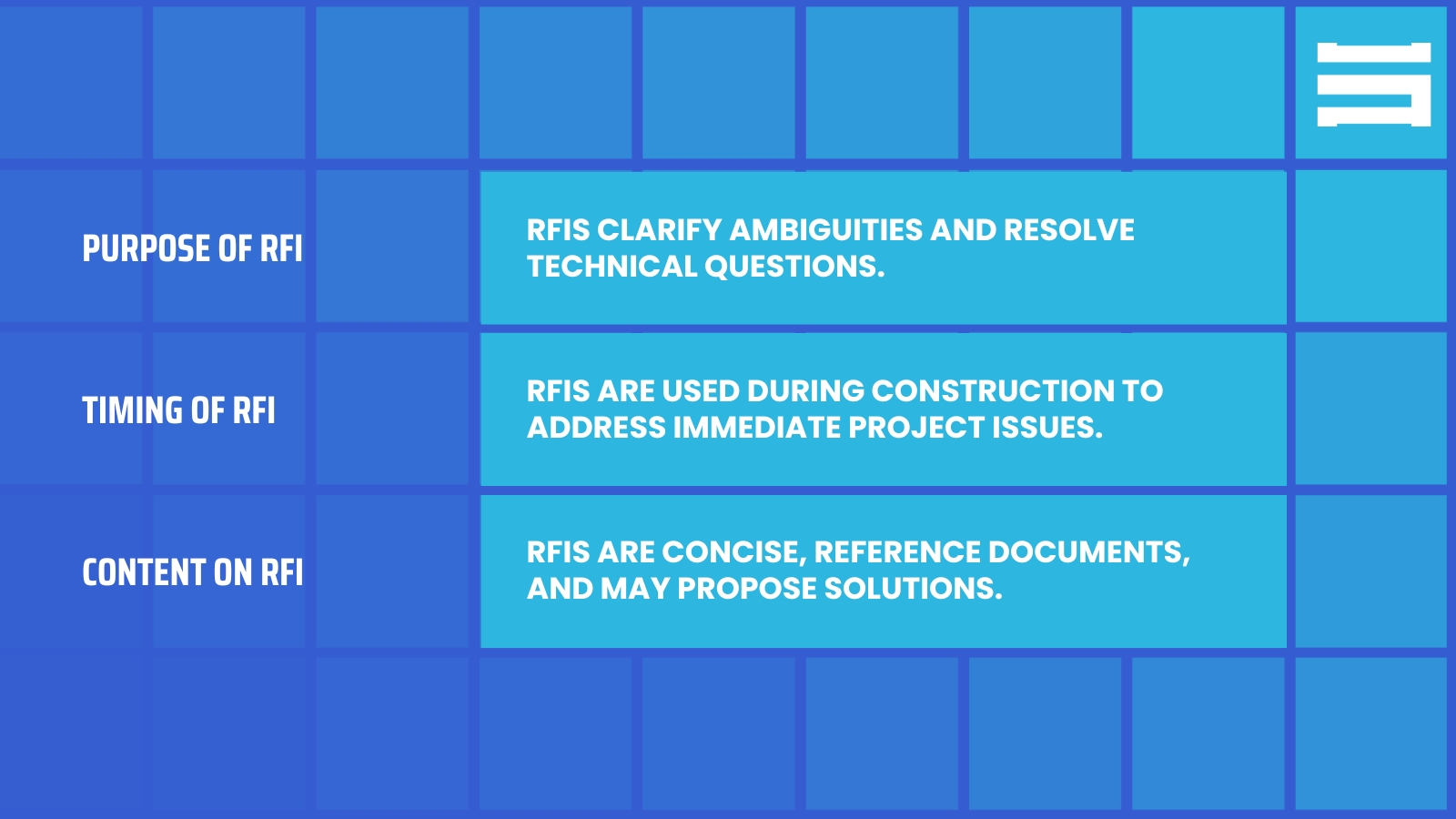
What Are Good RFI Questions for Inquiry?
Good RFIs are those that are specific, clear, and actionable. These questions aim to eliminate ambiguities, providing precise direction to all stakeholders. The key to drafting effective RFIs lies in their focus and relevance to the issue at hand. Asking proactive and impactful questions requires demonstrating the contractor’s expertise and experience to stakeholders.
- Specificity: A good RFI addresses a particular issue, such as clarifying dimensions, material requirements, or procedural conflicts. Example: "Could you confirm the type of insulation material specified for Section C, as there is a discrepancy between Drawing A-3 and Specification 21?"
- Clarity: The query should be simple and avoid unnecessary jargon to ensure it is easily understood by the respondent.
- Reference-Based: A good RFI provides context by referencing relevant project documents like drawings, contracts, or specifications.
- Action-Oriented: The question should lead to a specific decision or action, such as approval or modification of a design element.
Examples of Good RFI Questions
- "Does the fire rating requirement for Partition X include doors, or does it apply to walls only?"
- "Can you confirm the maximum load-bearing capacity for Beam Y detailed in Specification Z?"
- "Is there an updated drawing for Electrical Layout in Section D?"
Well-crafted RFIs save time and ensure swift, accurate responses. They prevent unnecessary back-and-forth communication and minimise project delays. Handling RFIs efficiently is critical to maintaining project timelines and ensuring seamless communication. Dealing with RFIs requires a systematic approach to ensure no query goes unanswered or unresolved.
Key Steps in Managing RFIs
- Logging RFIs: Every RFI should be logged into a centralised system (e.g., construction RFI software) with a unique identifier. This helps track the RFI's status and ensures accountability.
- Reviewing the Query: Assign the RFI to the relevant party (e.g., architect, engineer, or client) for review. Ensure the query is clear and actionable before passing it on.
- Responding in a Timely Manner: Establish deadlines for responding to RFIs, typically within 7-10 business days. If the issue is complex, provide a timeline for resolution to keep stakeholders informed.
- Documenting the Response: All responses should be written and archived. This ensures a clear record of the decision made, which can be useful for audits or disputes.
During the construction of a commercial building, a subcontractor raises an RFI to clarify the required fireproof coating for steel beams. The RFI is logged, reviewed by the project’s structural engineer, and answered within the agreed timeframe. The quick resolution allows the subcontractor to proceed without delays. The below are some best practices to follow;
-
Use standardised RFI templates to ensure consistency.
- Provide detailed, actionable responses that address the query thoroughly.
- Communicate delays in responses to maintain transparency.
What are the Benefits of an Accurate RFI?
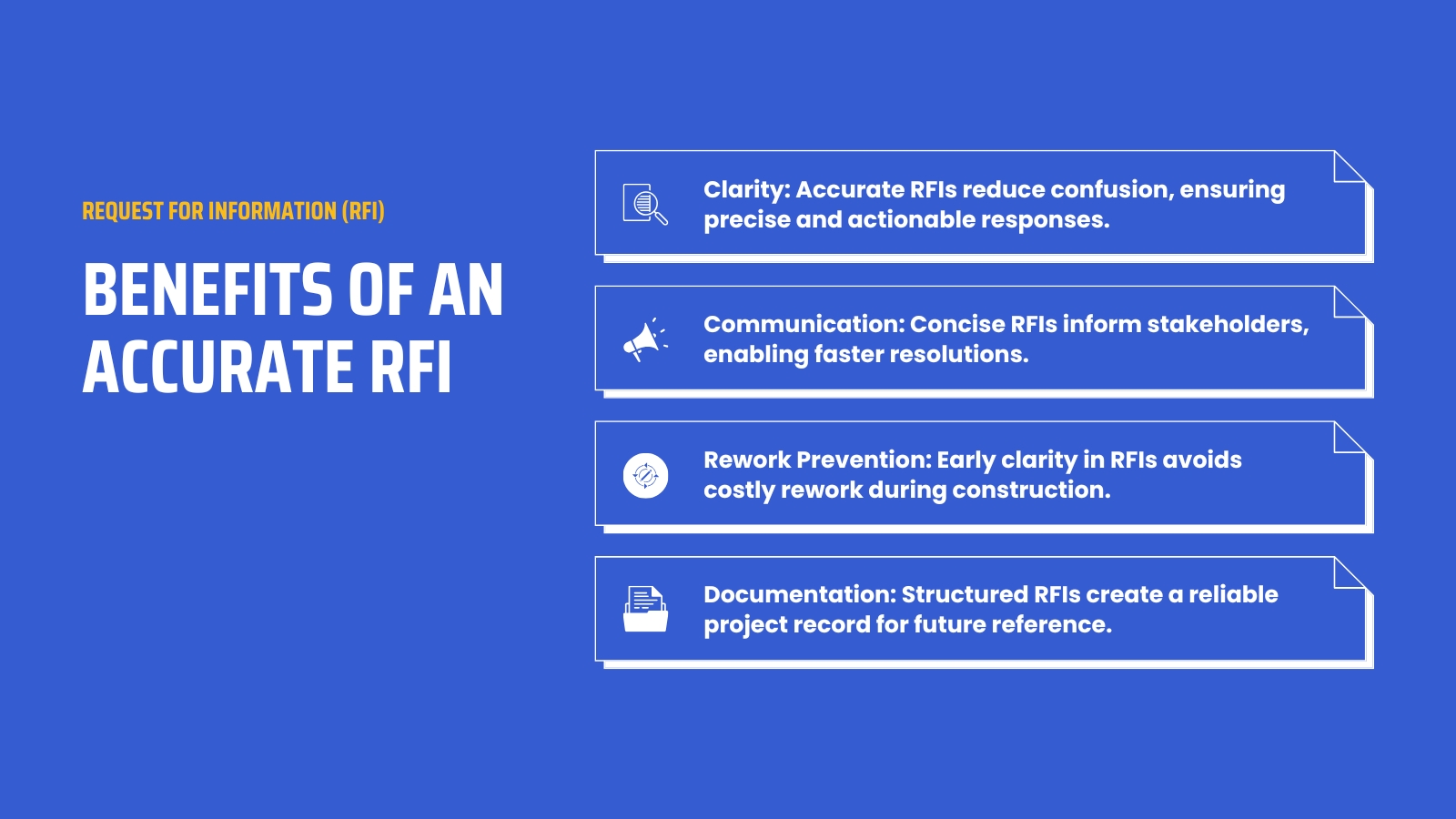
An accurate and well-drafted RFI is a cornerstone of effective project management, as it saves time, mitigates risks, and ensures smooth project execution.
- Clarity and Precision: Accurate RFIs provide a clear understanding of the issue, reducing confusion and misinterpretation. This precision ensures the response directly addresses the concern.
- Efficient Communication: A concise and well-organised RFI improves the communication flow between stakeholders, leading to faster resolutions.
- Avoidance of Rework: By resolving ambiguities early, accurate RFIs prevent costly rework or changes during construction.
- Improved Documentation: Well-structured RFIs contribute to a comprehensive project record, which can be referred to in future disputes or audits.
What is RFI Planning?
RFI planning refers to the proactive preparation for managing RFIs during a construction project. By identifying potential areas of ambiguity during the preconstruction phase, project managers can reduce the volume of RFIs raised during execution, saving time and resources.
- Review Project Documents Thoroughly: Before construction begins, all stakeholders (contractors, subcontractors, designers) should review drawings and specifications for potential gaps or inconsistencies.
- Anticipate Common Issues: For example, areas involving multiple trades, such as electrical and HVAC coordination, are likely to generate RFIs. Preparing detailed design coordination can minimise queries.
- Establish RFI Protocols: Clearly define how RFIs should be raised, who should respond, and the timeframe for resolution.
Conclusion
The RFI process is a cornerstone of communication in construction projects. By proactively planning, using structured approaches, and leveraging construction RFI software, teams can transform RFIs into a tool for efficiency and collaboration. Proper RFI management reduces ambiguities, ensures timely responses, and keeps projects on track, safeguarding timelines, budgets, and quality.
About us
Stonehaven is a trusted project management company and construction consultant based in Dubai, offering comprehensive construction management services across the UAE with offices located in Dubai, UK and Sri Lanka. As one of the leading project management companies in Dubai, we manage projects from inception to completion, ensuring quality, efficiency, and cost-effectiveness at every stage.
We deliver value through expert project management consultancy services, tailored to meet the unique needs of each client. Our core services include Cost Management, Project Management, Construction Supervision, Engineering Support, Design Support, and Marketing & Communications. Whether you’re looking for construction consultants or project managers in the UAE and wider GCC region, Stonehaven is your trusted partner for achieving excellence in your next project.
With expertise in project management services and RFI management, we help you optimise every stage of your project, ensuring success from inception to completion. Whether it’s managing RFIs or offering project management advisory services, our solutions are designed to minimise delays, maximise efficiency, and achieve exceptional results.
Contact Stonehaven today to revolutionise your RFI process and elevate your project management success.











